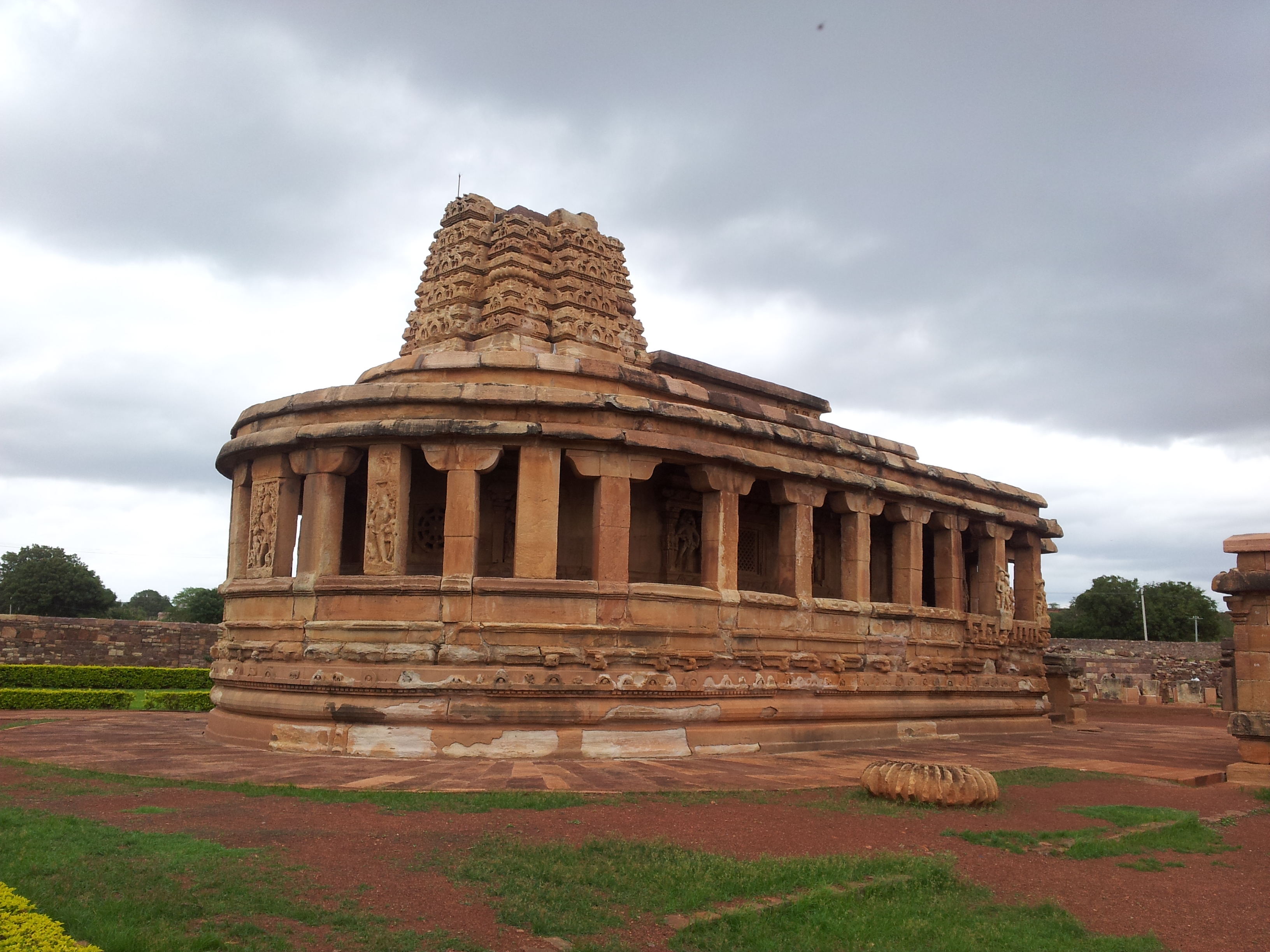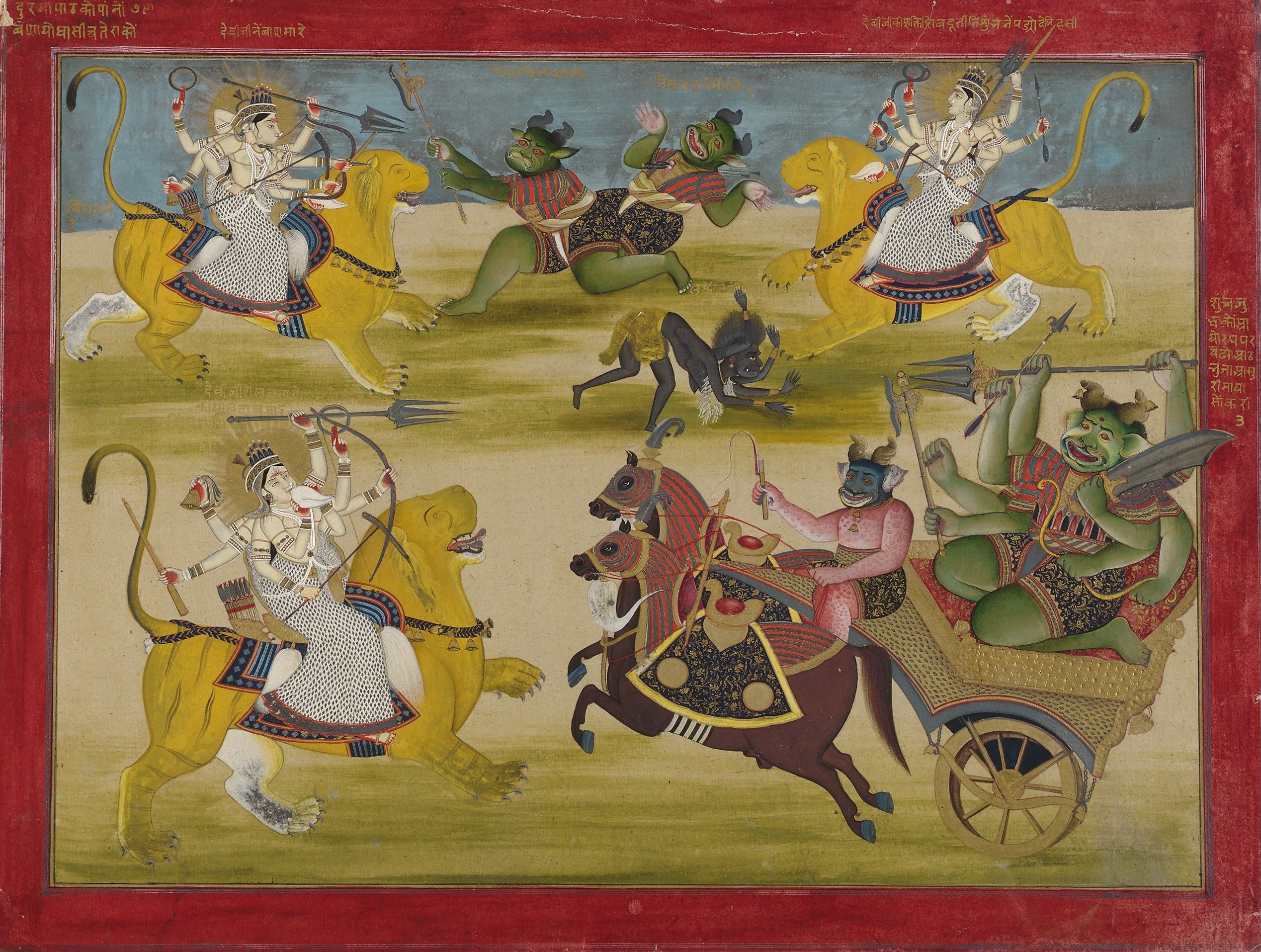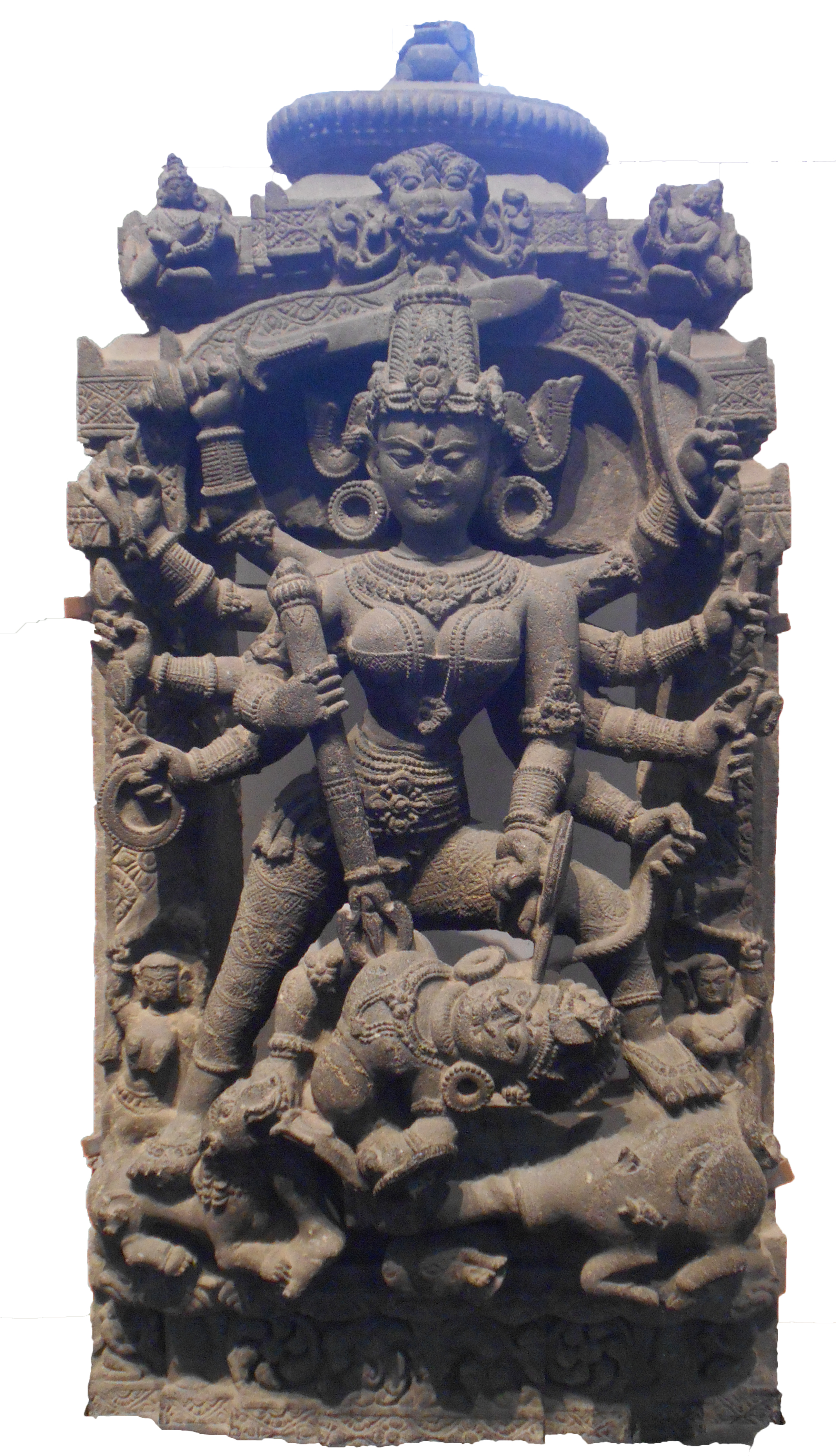|
Raktabīja
Raktabīja (, ) is an asura in Hinduism. According to the Puranas, he fought with Shumbha and Nishumbha against the goddesses Kali and Chandi, both forms of Durga. Raktabīja secured from Shiva a boon according to which if one drop of blood from his body fell on the battlefield, many Raktabījas would arise from the blood and fight the enemies. Each of these Raktabījas would also be like the others in the matter of strength, form, and weapons. Legend Origin According to the Puranas, there was an asura king called Danu. His two sons, Rambha and Karambha, who had no children, did Tapas at Pañcanada for the blessing of having children. Rambha and Karambha meditated upon Mālavaṭa Yakṣa, the former seated at the centre of the five fires and the latter standing in the water of a lake. When Indra found out about this, he decided to kill them. In the guise of a crocodile, Indra dragged Karambha away by the feet and killed him by drowning him. Then Indra went after Ram ... [...More Info...] [...Related Items...] OR: [Wikipedia] [Google] [Baidu] |
Rambha (asura)
Rambha is an asura in Hindu mythology. Rambha and Karambha are asura brothers, born as the descendants of Danu and Kashyapa. When they were young, both decided to perform penance to get special powers to establish the rule of Danavas in the universe. Penance and boon According to the Puranas, Rambha and Karambha did Tapas (Indian religions) at Pañcanada for the blessing of having children. Rambha and Karambha meditated upon Mālavaṭa Yakṣa, the former seated at the centre of the five fires and the latter standing in the water of a lake. Indra found out about this, he decided to kill them, first in the guise of a crocodile dragged Karambha away by the feet and killed him by drowning him. Then Indra went after Rambha to kill him but was saved by Agni. Angry at the death of his brother, Rambha decided to cut off his head and offer it as a sacrifice. When he was about to do so, Agni appeared and told him that suicide was worse than killing others, denouncing it as a great sin ... [...More Info...] [...Related Items...] OR: [Wikipedia] [Google] [Baidu] |
Kali
Kali (; , ), also called Kalika, is a major goddess in Hinduism, primarily associated with time, death and destruction. Kali is also connected with transcendental knowledge and is the first of the ten Mahavidyas, a group of goddesses who provide liberating knowledge. Of the numerous Hindu goddesses, Kali is held as the most famous. She is the preeminent deity in the Hindu tantric and the Kalikula worship traditions, and is a central figure in the goddess-centric sects of Hinduism as well as in Shaivism. Kali is chiefly worshipped as the Divine Mother, Mother of the Universe, and Divine feminine energy. The origins of Kali can be traced to the pre-Vedic and Vedic era goddess worship traditions in the Indian subcontinent. Etymologically, the term ''Kali'' refers to one who governs time or is black. The first major appearance of Kali in the Sanskrit literature was in the sixth-century CE text '' Devi Mahatmya''. Kali appears in many stories, with the most popular one bein ... [...More Info...] [...Related Items...] OR: [Wikipedia] [Google] [Baidu] |
Chandi
Chandi (, ) or Chandika () is a Hindu deity. Chandika is a form of goddess Durga. She shares similarities with the Goddess Chamunda, not only in name but also in attributes and iconography. Due to these similarities, some consider them to be the same deity, while others view them as different manifestations of Mahadevi. Both are often associated with other powerful goddesses like Durga, Katyayani, Kali and Kalaratri. The Goddess is particularly revered in Gujarat. History In the '' Devī Māhātmya.'' Chandi represents the killer of Chanda. the Supreme Divine is often referred to as Caṇḍī or Caṇḍikā. This name is derived from the Sanskrit root ''caṇḍa'', meaning “fierce” or “terrible.” Chandi is celebrated as the vanquisher of the demonic generals Chanda and Munda. According to Bhaskararaya, a prominent authority on Devi worship, Chandi embodies divine wrath and passion. The epithet of Chandi or Chandika appears in the Devi Mahatmya, a text dee ... [...More Info...] [...Related Items...] OR: [Wikipedia] [Google] [Baidu] |
Chanda And Munda
In Hinduism, in the Devi Mahatmya, Chanda and Munda are asuras (demons) in the service of demons Shumbha and Nishumbha. One day, they set their eyes upon Parvati and were overwhelmed by her beauty. They carried reports of this goddess to Shumbha. Shumbha desired to marry her. After the death of his lieutenant Dhumralochana at the hands of Devi, Shumbha sent Chanda and Munda to fight her, with orders to bring her to him by force. After Chanda and Munda approached the Devi, she turned black and Kali sprung from her forehead and killed them. Then, since she had slain Chanda and Munda, the Devi gave the name "Chamunda" to Kali. Afterwards, the demon Raktabīja was sent by the demons, but was also slain by Goddess Kali. According to Skanda Purana Purana, Chanda and Munda also worshipped Surya. See also * Rambha (asura) * Raktabīja * Shumbha and Nishumbha * Mahishasura * Dhumralochana * Sugriva (asura) Sugriva (, ), is a character In the ancient Hindu epic Ramayana. He i ... [...More Info...] [...Related Items...] OR: [Wikipedia] [Google] [Baidu] |
Devi Mahatmya
The ''Devi Mahatmya'' or ''Devi Mahatmyam'' () is a Hindu philosophical text describing the Goddess, known as Mahadevi, Adi Parashakti or Durga, as the supreme divine parabrahma, ultimate reality and creator of the universe. It is part of the Markandeya Purana, Mārkandeya Purāna (chapters 81 to 93). ''Devi Mahatmyam'' is also known as the ''Durgā Saptashatī'' () or Śata Chandī (शत् चंडी) and ''Chandi Path'' (). The text contains 700 verses arranged into 13 chapters. It is one of the most important texts in Shaktism, along with ''Devi-Bhagavata Purana'' and Devi Upanishad. The text is one of the earliest extant complete manuscripts from the Hindu traditions which describes reverence and worship of the feminine aspect of God. The ''Devi Mahatmyam'' describes a storied battle between good and evil, where the Devi manifesting as goddess Durga leads the forces of good against the demon Mahishasura—the goddess is very angry and ruthless, and the forces of goo ... [...More Info...] [...Related Items...] OR: [Wikipedia] [Google] [Baidu] |
Matrikas
Matrikas (Sanskrit: मातृका (singular), IAST: mātṛkā, lit. "mothers") also called Mataras or Matri, are a group of mother goddesses in Hinduism. The Matrikas are often depicted in a group of seven, the Saptamatrika(s) (Seven Mothers). However, they are also depicted as a group of eight, the Ashtamatrika(s). In the '' Brihat Samhita'', Varahamihira says that "Matrikas are forms of Parvati taken by her with cognizance of (different major Hindu) gods corresponding to their names." They are associated with these gods as their energies (''Shaktis''). Brahmani emerged from Brahma, Vaishnavi from Vishnu, Maheshvari from Shiva, Indrani from Indra, Kaumari from Kartikeya, Varahi from Varaha and Chamunda from Chandi. And additionals are Narasimhi from Narasimha and Vinayaki from Ganesha. Originally the seven goddesses of the seven stars of the star cluster of the Pleiades, they became quite popular by the seventh century CE and a standard feature of the Hindu goddes ... [...More Info...] [...Related Items...] OR: [Wikipedia] [Google] [Baidu] |
Shumbha And Nishumbha
Shumbha (शुम्भ) and Nishumbha (निशुम्भ) are two asuras in Hindu mythology, featured in the ''Devi Mahatmya''. In their legend, they were slain by the goddess Kaushiki. Legend The story of Shumbha and Nishumbha begins in the fifth chapter of the ''Devi Mahatmya''. Durga retells how two asura brothers sought to conquer the three worlds by subjecting themselves to severe penance and purification rituals so that no man or asura could destroy them. Shumbha and Nishumbha traveled to Pushkara, a sacred site, and remained there in prayer for ten thousand years. The creator deity Brahma saw the brothers' penance, and was pleased, granting them the boon they requested. Chanda and Munda, two lesser asuras in the service of Shumbha, encountered the goddess Durga, and were overwhelmed by her beauty. They carried reports of this goddess to Shumbha, who sought to possess Durga. Shumbha sent the asura Sugriva to court Parvati, but she rejected his advances. It was the ... [...More Info...] [...Related Items...] OR: [Wikipedia] [Google] [Baidu] |
Mahishasura
Mahishasura (, ) is a bovine asura in Hinduism. He is depicted in Hindu texts, Hindu literature as a deceitful demon who pursued his evil ways by shape-shifting. Mahishasura was the son of the asura Rambha (asura), Rambha and the brother of buffalo-demoness named Mahishi (demoness), Mahishi. He was ultimately killed by the goddess Durga with her trishula (trident) after which she gained the epithet Mahishasuramardini ("Slayer of Mahishasura"). Mahishasura had a son named Gajasura. The Navaratri ("Nine Nights") festival eulogises this battle between Mahishasura and Durga, culminating in Vijaya Dasami, Vijayadashami, a celebration of his ultimate defeat. This story of the "triumph of good over evil" carries profound symbolism in Hinduism, particularly Shaktism, and is both narrated as well as reenacted from the Devi Mahatmya at many South and Southeast Asian Hindu temples. The ''Mahishasura Mardini Stotra'' by Adi Shankara was written to commemorate her legend. Legend Mahis ... [...More Info...] [...Related Items...] OR: [Wikipedia] [Google] [Baidu] |
Devi Bhagavata Purana
The Devi Bhagavata Purana (, '), also known as the Devi Purana or simply Devi Bhagavatam, is one of the eighteen Mahapurana (Hinduism), Mahapuranas as per Shiva Purana of Hinduism. Composed in Sanskrit language, Sanskrit by Vyasa, Veda Vyasa, the text is considered a major purana for Devi worshippers (Shaktism, Shaktas). It promotes ''bhakti'' (devotion) towards Mahadevi, integrating themes from the Shaktadvaitavada tradition (a syncretism of Samkhya and Advaita Vedanta). While this is generally regarded as a Shakta Purana, some scholars such as Dowson have also interpreted this Purana as a Shaivism, Shaiva Purana. The Purana consists of twelve cantos with 318 chapters. Along with the ''Devi Mahatmya'', it is one of the most important works in Shaktism, a tradition within Hinduism that reveres Devi or Shakti (Goddess) as the primordial creator of the universe, and as Brahman (ultimate truth and reality). It celebrates the divine feminine as the origin of all existence: as th ... [...More Info...] [...Related Items...] OR: [Wikipedia] [Google] [Baidu] |
Vāyu
Vayu (; ), also known as Vata () and Pavana (), is the Hindu deities, Hindu god of the winds as well as the divine messenger of the gods. In the ''Vedic scriptures'', Vayu is an important deity and is closely associated with Indra, the king of gods. He is mentioned to be born from the breath of Supreme Being Vishvarupa, Vishvapurusha and also the first one to drink Soma (drink), Soma. The ''Upanishads'' praise him as ''Prana'' or 'life breath of the world'. In the later Hindu scriptures, he is described as a dikpala (one of the guardians of the direction), who looks over the north-west direction. The Hindu epics describe him as the father of the god Hanuman and Bhima. The followers of the 13th-century saint Madhva believe their guru as an avatar, incarnation of Vāyu. They worship the wind deity as Mukhyaprana () and consider him as the son of the god Vishnu. Connotations The word for air (classical element), air (''vāyu'') or wind (''pavana'') is one of the Classical eleme ... [...More Info...] [...Related Items...] OR: [Wikipedia] [Google] [Baidu] |
Archery
Archery is the sport, practice, or skill of using a Bow and arrow, bow to shooting, shoot arrows.Paterson ''Encyclopaedia of Archery'' p. 17 The word comes from the Latin ''arcus'', meaning bow. Historically, archery has been used for hunting and combat. In modern times, it is mainly a competitive sport and recreational activity. A person who practices archery is typically called an archer, bowman, or toxophilite. History Origins and ancient archery The oldest known evidence of arrows (not found with surviving bows) comes from South Africa, South African sites such as Sibudu Cave, where the remains of bone and stone arrowheads have been found dating approximately 72,000 to 60,000 years ago.Backwell L, d'Errico F, Wadley L.(2008). Middle Stone Age bone tools from the Howiesons Poort layers, Sibudu Cave, South Africa. Journal of Archaeological Science, 35:1566–1580. Backwell L, Bradfield J, Carlson KJ, Jashashvili T, Wadley L, d'Errico F.(2018). The antiquity of bow-and-arro ... [...More Info...] [...Related Items...] OR: [Wikipedia] [Google] [Baidu] |
Bubalina
Bubalina is a subtribe of wild cattle that includes the various species of true buffalo. Species include the African buffalo, the anoas, and the wild water buffalo (including the domesticated variant water buffalo). Buffaloes can be found naturally in sub-Saharan Africa, South Asia and Southeast Asia, and domestic and feral populations have been introduced to Europe, the Americas, and Australia. In addition to the living species, bubalinans have an extensive fossil record where remains have been found in much of Afro-Eurasia. Despite being sometimes referred to as buffaloes, bison are not members of the Bubalina, but are instead classified in the subtribe Bovina. Taxonomy Placement within Bovini The majority of phylogenetic work based on ribosomal DNA, chromosomal analysis, autosomal introns and mitochondrial DNA has recovered three distinctive subtribes of Bovini: Pseudorygina (represented solely by the saola), Bubalina, and Bovina (which today are represented by the gener ... [...More Info...] [...Related Items...] OR: [Wikipedia] [Google] [Baidu] |







